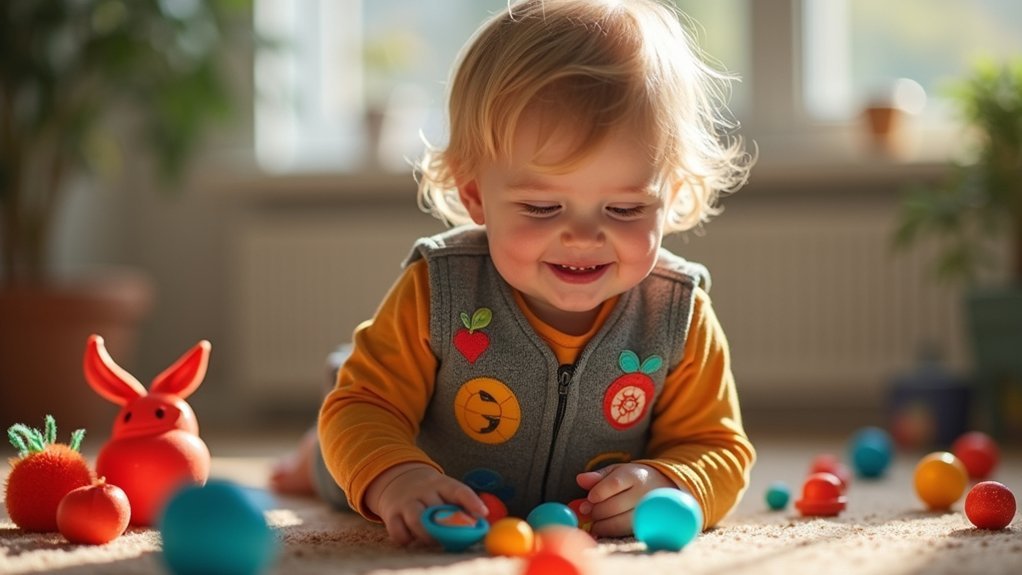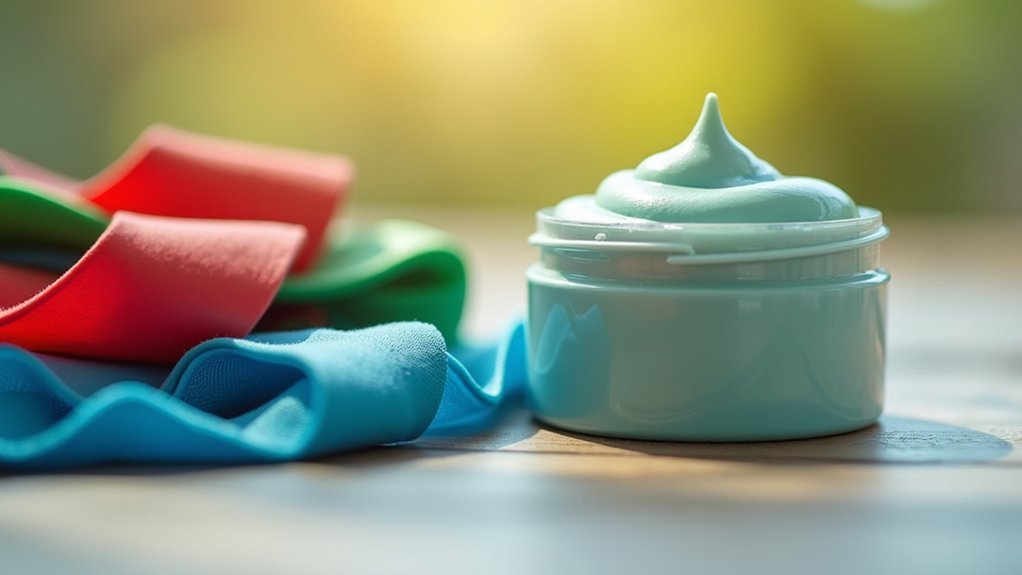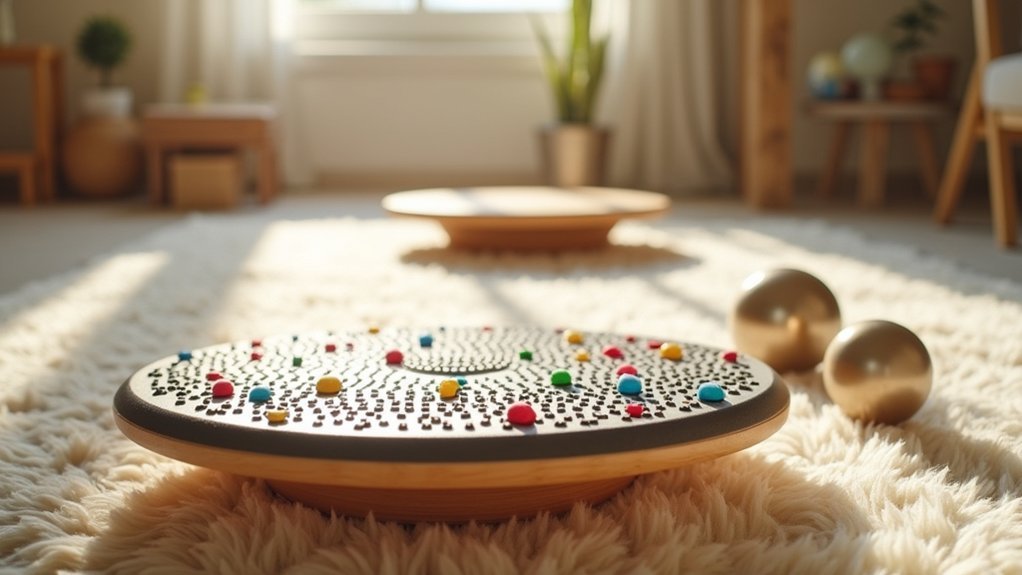Three powerful proprioception tools for cognitive challenges include weighted vests that provide calming deep pressure at 5-10% of body weight, balance boards that enhance spatial awareness through constant muscle adjustment, and resistance bands that deliver essential neuromuscular feedback. You’ll see improved focus, body awareness, and self-regulation when you incorporate these tools into daily routines for 10-15 minutes. Discover how these sensory supports can transform attention and learning capabilities in children’s developing systems.
Weighted Vests and Compression Clothing for Body Awareness

Why do weighted vests and compression clothing make such a difference for children with cognitive challenges?
These powerful proprioceptive input tools provide deep pressure that grounds children in their physical space.
Weighted vests, when properly fitted at 5-10% of your child’s body weight, greatly improve body awareness while reducing fidgeting and increasing on-task behavior.
Properly weighted vests can transform a child’s focus by calming their body and anchoring their attention to learning tasks.
Compression clothing works similarly by delivering consistent gentle pressure that helps regulate sensory processing disorder symptoms.
Both options create calming effects by activating the proprioceptive system – the body’s internal positioning sense.
You’ll notice improved focus as these sensory strategies help your child’s brain better organize incoming information.
When implementing these tools, watch for improved proprioceptive awareness – your child will likely demonstrate better coordination and attention during daily activities, making learning experiences more productive and less overwhelming.
Balance Boards and Stability Tools for Spatial Perception
While weighted items provide deep pressure input, balance boards and stability tools engage different proprioceptive pathways by challenging your child’s equilibrium.
These devices activate the proprioceptive system by requiring constant muscle adjustments, enhancing spatial perception and body awareness.
You’ll notice improved cognitive performance as your child’s brain processes this rich sensory input.
Balance training on wobble cushions or stability boards provides continuous proprioceptive feedback that can markedly boost focus and attention for children with cognitive challenges.
Try incorporating these tools into daily routines for just 10-15 minutes.
The sensory experience they create strengthens core muscles while simultaneously developing the neural connections needed for better coordination.
Research shows consistent use of stability tools can enhance proprioceptive function, making them valuable additions to any sensory integration program.
Resistance Bands and Therapy Putty for Neuromuscular Feedback

Resistance bands and therapy putty offer powerful neuromuscular feedback that directly enhances your child’s proprioceptive awareness.
When your child manipulates therapy putty, they receive immediate sensory input that improves cognitive focus while developing fine motor skills.
Similarly, resistance bands create adjustable tension that builds muscle strength while providing essential proprioceptive feedback during movement.
Incorporate these tools regularly to address proprioceptive challenges:
- Use resistance bands during morning routines to “wake up” your child’s sensory system before school
- Offer therapy putty during homework time to improve focus through consistent sensory input
- Combine both tools in guided play sessions to maximize neuromuscular feedback opportunities
You’ll notice improvements in spatial awareness, body positioning, and overall self-regulation as your child’s brain learns to process and respond to these targeted proprioceptive experiences.
Frequently Asked Questions
What Tools Are Used in Proprioception Therapy?
You’ll use therapy balls, balance boards, weighted materials, therapy putty, resistance bands, fidget tools, balance stepping stones, textured seat cushions, and resistive hand materials for proprioception therapy. These tools enhance body awareness and sensory input.
What Are the Proprioceptive Exercises for ADHD?
For ADHD, you’ll benefit from trampoline jumping, therapy ball activities, pushing weighted carts, balance beam walking, and crawling exercises. These proprioceptive activities provide deep pressure input that improves your focus and reduces impulsivity.
What Are the Assessment Tools for Proprioception?
You can assess proprioception using the Bruininks-Oseretsky Test, SIPT, clinical observations during functional tasks, Sensory Profile questionnaires, and dynamic balance assessments like the Star Excursion Balance Test for thorough evaluation.
What Are the 4 Types of Proprioception?
The four types of proprioception are static proprioception (body position when still), dynamic proprioception (body movement awareness), interoception (internal sensations), and exteroception (external sensory feedback). You’ll recognize these as fundamental to your body awareness system.
In Summary
You’ve now discovered three essential tools to support proprioceptive development. Whether you’re using weighted vests for calming focus, balance boards for improved coordination, or resistance bands for enhanced body awareness, you’ll find these options offer practical benefits for cognitive challenges. Don’t underestimate the power of these simple interventions—they’re creating neural pathways that strengthen both body and mind. Try incorporating them into your daily routine for consistent progress.





Leave a Reply